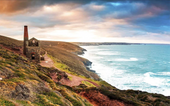Photographer’s Guide to Wistman’s Wood: A Hidden Gem in Dartmoor National Park

Photographer’s Guide to Wistman’s Wood: A Hidden Gem in Dartmoor National Park
Nestled within the rugged beauty of Dartmoor National Park lies Wistman’s wood, a small but magical oak woodland that has captivated photographers, hikers, and nature enthusiasts for generations. Known for its ancient, twisted trees draped in moss and lichen, with rugged granite boulders scattered throughout, this woodland is a dream location for anyone seeking to capture atmospheric and otherworldly imagery. This guide explores the best ways to photograph Wistman’s Wood, from the gear you’ll need to the techniques for bringing out its mystical charm.
Why Wistman’s Wood?
Wistman’s wood is more than just a collection of trees; it’s a landscape photographer’s playground. The forest exudes an ancient, almost mythical aura, with gnarled oak trees contorted into surreal shapes. The damp climate of Dartmoor encourages thick moss and lichen to thrive on the trunks and boulders, adding texture and vibrancy to the scene. These unique features make it a fantastic location for creating atmospheric, ethereal compositions.
While small—you could walk from one end to the other in under five minutes—it’s dense with photographic opportunities. The challenge is isolating compositions amidst the chaos, but with patience and creativity, this woodland rewards you with some of the most stunning and intimate forest scenes imaginable.
The Best Time to Photograph
The mood of Wistman’s Wood shifts dramatically depending on the time of day and weather. For the best results:
- Overcast Days: The soft, diffused light on cloudy days reduces harsh shadows and brings out the vibrant greens of moss and lichen. Avoid direct sunlight, which can create overly contrasty scenes that detract from the woodland’s subtle details.
- Early Morning or Late Afternoon: While the wood isn’t large, arriving early or staying late ensures you have time to explore and make the most of the light. Sunrise and sunset often bring dramatic skies, adding atmosphere to wider landscape shots around the woodland.
- Misty or Foggy Weather: Mist transforms Wistman’s Wood into a fairytale setting, simplifying chaotic backgrounds and emphasizing the gnarled silhouettes of the trees. Creative editing techniques can help emulate this effect if mist isn't in the forecast.
Recommended Lenses and Gear
Wistman’s wood is a versatile location, and your lens choice can drastically affect the style of your images:
- 50mm Prime Lens (f/1.4): An excellent choice for isolating details, this lens creates a shallow depth of field, soft bokeh, and dreamy backgrounds. It’s beneficial for capturing individual tree trunks, twisted branches, or isolated elements like bluebells.
- 16-35mm Wide-Angle Lens: Ideal for capturing the entire woodland scene, this lens allows you to include foreground elements like moss-covered boulders while still showcasing the dense canopy above. A wider field of view also helps convey the scale and drama of the twisted trees.
- Macro Lens: If you enjoy focusing on intricate details like moss, lichen, or fungi, a macro lens can open up a new dimension of photography here.
- Tripod: While uneven ground can make tripod use tricky, it’s essential for long exposures or precise compositions. Consider a compact, lightweight model that’s easy to manoeuvre in tight spaces.
Finding Compositions in the Chaos
One of the biggest challenges in Wistman’s Wood is isolating a solid composition. The dense layering of trees, rocks, and moss can feel overwhelming at first, but there are strategies to help you find order in the chaos:
- Look for Twisted Patterns: Focus on the unique, contorted shapes of the trees. Many trunks resemble hands, claws, or abstract figures, making them intriguing focal points.
- Use Foreground Elements: Incorporate granite boulders or clusters of ferns to add depth to your images. Position them in the foreground to guide the viewer’s eye into the frame.
- Shoot Upward: Capturing the canopy can emphasize the dramatic shapes of the branches and create a sense of scale. This technique is particularly effective on misty days as the fog simplifies the background.
- Experiment with Depth of Field: A wide aperture (e.g., f/1.4 or f/2) can isolate individual elements while blurring the chaotic background. Conversely, use a narrower aperture (e.g., f/8 or f/11) to capture more detail and texture.
Post-Processing Tips
Wistman’s wood lends itself to creative editing. Even if the weather doesn’t provide mist or fog, you can add atmospheric effects in post-processing to enhance the mood:
- Emphasize Textures: Use contrast and clarity adjustments to reveal the intricate details of moss and bark.
- Simulate Fog: Selective use of radial gradients or brushes can create the illusion of mist, softening the background while keeping key elements sharp.
- Tone Down Colors: Muted greens and browns often feel more natural and cohesive for woodland scenes, avoiding overly saturated tones.
Hidden Gems in the Wood
While exploring, keep an eye out for unique features:
- The “Devil Tree”: A particularly twisted tree that looks like it has horns and eyes. Its eerie appearance has made it a favourite among photographers.
- Bluebells: Occasionally, you may spot stray bluebells along the paths, perfect for an isolated detail shot.
- Granite Boulders with Patterns: Some rocks appear to have been chiselled in ancient times, though their origins remain unclear.
Practical Tips for Visiting
- Plan Your Route: The walk to Wistman’s Wood takes about 20-30 minutes from the nearest car park. Wear sturdy boots, as the paths can be uneven and muddy.
- Check the Weather: Dartmoor’s conditions can change rapidly, so be prepared for rain even on seemingly clear days.
- Pack Light: Navigating the woodland is easier with minimal gear. Bring only what you need, and consider a comfortable backpack for carrying your equipment.
- Respect the Environment: Wistman’s Wood is a fragile ecosystem. Stick to marked paths and avoid disturbing the vegetation.
Final Thoughts
Wistman’s wood is a challenging yet immensely rewarding location for landscape photographers. Its ancient trees, vibrant textures, and unique atmosphere make it a place where creativity thrives. Whether you’re a seasoned photographer or a beginner looking for inspiration, this woodland offers countless opportunities to hone your craft and create unforgettable images.
So, grab your camera, lace up your boots, and head into the heart of Dartmoor. Wistman’s wood awaits, ready to inspire and challenge you with its natural beauty.
Meet the Author:
I am a Devon based photographer, who enjoys travel, hiking, rugby and photographing the beautiful world in which we live in, I see photography as a creative expression upon visiting beautiful places. Each picture often tells a story.
Thank you for reading this article, please feel to share it with your friends and please check out all my photography - Wall Art and Framed Prints and our Dartmoor Landscape Photography
Thanks
Sebastien Coell Photography




